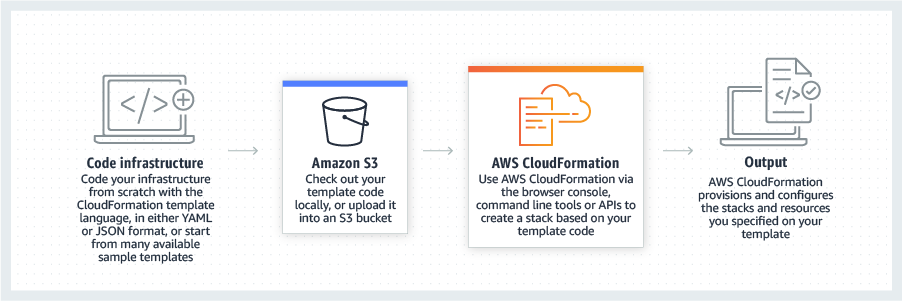
AWS CloudFormation
DevOps Services of Amazon Web Services
AWS CloudFormation
With AWS CloudFormation, AWS or third-party resources can be easily modeled, as well as quickly and consistently provisioned and managed throughout the lifecycle. This is done by handling Infrastructure as Code. A CloudFormation template describes the desired resources and their dependencies. This enables launch and configuration together as a stack. By using a template, a full stack can be created, updated, and deleted as a single entity as many times as needed, rather than having to manage resources individually. This allows stacks to be managed and provisioned across multiple AWS accounts and regions.
Here's how AWS CloudFormation works:

Bildquelle: Amazon Web Services
The advantages of AWS WAF at a glance
Automate standard processes
CloudFormation can automate best practices for DevOps and GitOps, including starting with a Git repository and deploying via a CI/CD pipeline. Pipeline integrations such as GitHub Actions and AWS CodePipeline can simplify auditing changes and trigger automated deployments.
Global scaling of infrastructure
Enterprise resource scaling can be managed with CloudFormation templates. This enables standards for security, compliance, and configuration to be maintained across all AWS accounts and regions. Templates and parameters ensure easy scaling and sharing of best practices and enterprise policies. In addition, CloudFormation StackSets allow you to create, update, and delete stacks across multiple AWS accounts and regions with one execution.
Integration with other AWS services
CloudFormation can be integrated with other AWS services to further automate overarching resource management. Examples include the following: AWS Identity and Access Management (IAM) for access control, AWS Config for compliance, and AWS Service Catalog for distribution of finished applications and further governance control. Integrations with CodePipeline and other builder tools allow you to leverage the latest DevOps best practices and improve automation, testing, and controls.
Private and third-party resource management
Third-party application resources can be modeled, deployed, and managed alongside AWS resources such as monitoring, team productivity, incident management, and version control tools.
Expansion of CloudFormation with the community
The AWS CloudFormation GitHub organization provides open source projects to extend the capabilities of CloudFormation. With CloudFormation Registry and CloudFormation CLI, resource providers can be self-defined and created to securely and systematically automate the creation of resources.
We implement AWS CloudFormation for you!

As an AWS Premier Tier Services Partner with DevOps Competency, the Arvato Systems AWS Business Group draw on a solid framework of DevOps experience and expertise, and implement AWS CloudFormation according to established best practices.
Your Contact for Amazon Web Services




